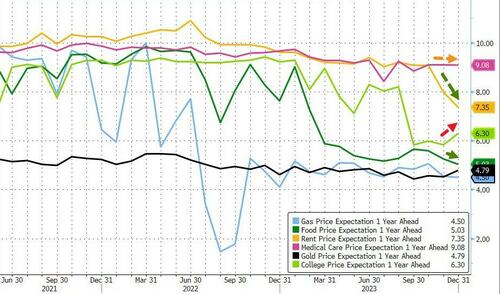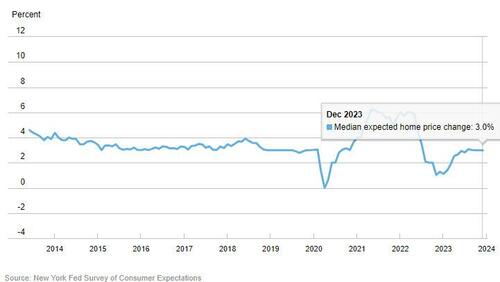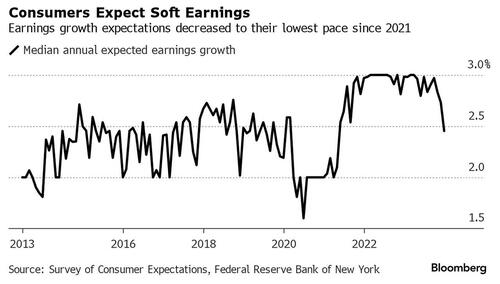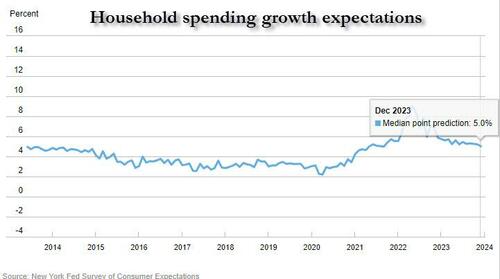
 Image Source: PixabayAfter a few months of late summer increases in the 1-Year inflation expectation as tracked by the NY Fed’s monthly consumer survey, December saw the third consecutive decline in this series which traditionally is also a proxy for the price of oil, and which last month dropped to the lowest since Jan 2021. The drop in 1-year inflation expectations was matched by moves in the other series, as both the 3 and 5-year inflation expectations also dropped notably in the last month of the year. And while that would be great news in isolation, it wasn’t isolated, because as the NY Fed also found, the disinflation data is actually the “bad kind” since the December survey found that earnings growth and spending growth expectations also decreased to their lowest recorded levels since 2021.Here are some more details: as shown in the chart below, inflation expectations at the one-year horizon decreased to 3.01% in December from 3.36% in November, while median inflation expectations at the three- and five-year ahead horizon also dropped: to 2.6% from 3.0% at the three-year ahead horizon, and to 2.5% from 2.7% at the five-year ahead horizon.
Image Source: PixabayAfter a few months of late summer increases in the 1-Year inflation expectation as tracked by the NY Fed’s monthly consumer survey, December saw the third consecutive decline in this series which traditionally is also a proxy for the price of oil, and which last month dropped to the lowest since Jan 2021. The drop in 1-year inflation expectations was matched by moves in the other series, as both the 3 and 5-year inflation expectations also dropped notably in the last month of the year. And while that would be great news in isolation, it wasn’t isolated, because as the NY Fed also found, the disinflation data is actually the “bad kind” since the December survey found that earnings growth and spending growth expectations also decreased to their lowest recorded levels since 2021.Here are some more details: as shown in the chart below, inflation expectations at the one-year horizon decreased to 3.01% in December from 3.36% in November, while median inflation expectations at the three- and five-year ahead horizon also dropped: to 2.6% from 3.0% at the three-year ahead horizon, and to 2.5% from 2.7% at the five-year ahead horizon. The survey’s measure of disagreement across respondents (the difference between the 75th and 25th percentile of inflation expectations) increased at the one-year ahead horizon, and decreased at the three-year and five-year ahead horizons.Amusingly, inflation views among those over age 60 retreated to a fresh three-year low, while every age group was also at or near a multi-year low. One almost wonders just who are these people the NY fed “randomly” calls up to “survey.”
The survey’s measure of disagreement across respondents (the difference between the 75th and 25th percentile of inflation expectations) increased at the one-year ahead horizon, and decreased at the three-year and five-year ahead horizons.Amusingly, inflation views among those over age 60 retreated to a fresh three-year low, while every age group was also at or near a multi-year low. One almost wonders just who are these people the NY fed “randomly” calls up to “survey.” The latest survey comes three days before the release of December CPI report, where economists forecast headline inflation will post a modest increase to 3.2% from 3.1% in November, while core inflation dips to 3.8% from 4.0% YoY.The pullback in consumers’ near-term inflation views reflected a number of factors, but most notably a pullback in the expected price changes for food and rent. The cost of college is anticipated to climb at a faster rate, while forecasts for gasoline prices and medical care stabilized: as shown in the next chart, the expected price changes for the cost of a college education increased by 0.5 percentage points to 6.3%, decreased by 0.3 percentage point for food to 5.0%, decreased by 0.7 percentage point for rent to 7.3%, and remained flat for gas at 4.5% and the cost of medical care at 9.1%.
The latest survey comes three days before the release of December CPI report, where economists forecast headline inflation will post a modest increase to 3.2% from 3.1% in November, while core inflation dips to 3.8% from 4.0% YoY.The pullback in consumers’ near-term inflation views reflected a number of factors, but most notably a pullback in the expected price changes for food and rent. The cost of college is anticipated to climb at a faster rate, while forecasts for gasoline prices and medical care stabilized: as shown in the next chart, the expected price changes for the cost of a college education increased by 0.5 percentage points to 6.3%, decreased by 0.3 percentage point for food to 5.0%, decreased by 0.7 percentage point for rent to 7.3%, and remained flat for gas at 4.5% and the cost of medical care at 9.1%. Median home price growth expectations remained unchanged at 3.0%, remaining well above the series 12-month trailing average of 2.4%. And with the Fed preparing to cut rates, this is about to explode higher.
Median home price growth expectations remained unchanged at 3.0%, remaining well above the series 12-month trailing average of 2.4%. And with the Fed preparing to cut rates, this is about to explode higher. The bigger problem for the Fed is that while overall inflation expectations dipped, it wasn’t for good reasons; indeed, the expected year-ahead earnings growth fell to the lowest level since April 2021 as median expected growth in household income decreased by 0.1 percentage point to 3.0%. The decline was driven by respondents with a high school diploma or less, the New York Fed said. People earning less than $50,000 expect 1% income growth, while those earning $100,000 or more expect 3%. The series has been moving within a narrow range of 2.9% to 3.3% since January 2023.
The bigger problem for the Fed is that while overall inflation expectations dipped, it wasn’t for good reasons; indeed, the expected year-ahead earnings growth fell to the lowest level since April 2021 as median expected growth in household income decreased by 0.1 percentage point to 3.0%. The decline was driven by respondents with a high school diploma or less, the New York Fed said. People earning less than $50,000 expect 1% income growth, while those earning $100,000 or more expect 3%. The series has been moving within a narrow range of 2.9% to 3.3% since January 2023. Median household spending growth expectations also declined by 0.2% point to 5.0%, reaching the lowest level recorded since September 2021. Still, the series remains above its February 2020 pre-pandemic level of 3.1%.
Median household spending growth expectations also declined by 0.2% point to 5.0%, reaching the lowest level recorded since September 2021. Still, the series remains above its February 2020 pre-pandemic level of 3.1%. Despite the pullback in expected earnings growth, respondents were more upbeat about the jobs market. The perceived probability of losing one’s job fell, and more consumers anticipate the unemployment rate will be lower one year from now. A larger share of respondents also expect looser credit conditions in the coming year.Here are some other observations from the latest survey, first focusing on the labor market:
Despite the pullback in expected earnings growth, respondents were more upbeat about the jobs market. The perceived probability of losing one’s job fell, and more consumers anticipate the unemployment rate will be lower one year from now. A larger share of respondents also expect looser credit conditions in the coming year.Here are some other observations from the latest survey, first focusing on the labor market:
… and on consumers’ household finances:
More in the full NY Fed note is some more details.More By This Author:Boeing & Spirit AeroSystems Shares Plunge After Max 737-9 Max Door Blowout IncidentFor Third Straight Year, Texas Is Top Destination For U-Haul RentersAutomobile Sticker Shock Sinks In















